

Fig 1: So far, 81,000 containers per hour have been processed on the Ergobloc. A figure that Krones has now exceeded. (Photo credit: Krones)
Bloc Technology
A quantum leap for block technology - Part 1
With sophisticated technology from KHS, RAMSEIER Suisse AG in Sursee in Switzerland recently commissioned a very special aseptic line: one that is flexible, highly efficient and perfectly tailored to the company’s high demand for quality.
But changes in human behaviors can be observed not only in where people are choosing to live. Consumer habits are also shifting. When it comes to beverages, the trend is very clearly toward onthe-go consumption, which is driving increased demand for packaged beverages, especially in emerging market and developing countries. According to Global Data, packaged water is expected to see the strongest growth. Already the largest global beverage segment by far (2021 share: 33.8%), it is benefiting from the rising need for clean drinking water in emerging market and developing countries and the health and wellness trend in industrialized countries. Global Data expects demand for packaged water to increase by 3.2% on average each year from 2021 to 2024
Because water is mostly filled into PET bottles, this container type will continue to play a key role in the future. According to Global Data, growth rates through 2024 will average 3.7% annually. Last year, PET containers made up 29.1% of all units filled worldwide, a far larger share of the market than glass bottles (20.1%) and metal cans (18%).
In short, these statistics suggest that water in PET will continue to see the highest growth and consumption rates.
And water bottlers will need additional production capacity to meet demand. Greater flexibility and line efficiency will also be necessary. Bottlers often have to explore whether it makes more sense to install two smaller lines or a single larger one. And contrary to commonly held opinion, a single larger line offers better performance in terms of both energy and media consumption per packaged unit. Thus, alongside other advantages, the larger line is also more sustainable than smaller, stand-alone lines.
Well equipped with a block solution
Krones addressed all of these developments when it debuted the ErgoBloc L back in 2010. The ErgoBloc L was the first line in the beverage industry to completely do away with the need for conveyors – and thus enable bottlers to achieve efficient production on a small footprint. It also made it possible for the first time to efficiently run the entire wet end with a single operator. And that is still possible today, with a number of further developments added over the years. Right now, the block solution still stands apart in terms of higher performance and efficiency and lower energy and media consumption.
New milestone in block technology: 100,000 containers per hour
Krones’ block technology has now reached its latest milestone and, with that, broken through a significant barrier: processing 100,000 containers per hour on a single block.

That was made possible in part by the Contiform 3 Speed, which Krones introduced to the market in 2018. At that time, it handled 2,750 containers per cavity per hour – achieving a speed that remains unmatched to this day. The key to this achievement was to eliminate the pressure pad in the mold hanger. On the 3 Speed, the two halves of the mold are held together simply by a redesigned locking device. The elimination of the pressure pad means that molds for bottles up to 2.0 liters can be used in the same space as what previously would have accommodated only a small-mold blowing module, which is on average 22 percent smaller than the comparable Contiform 3 Pro blowing module. This new configuration has benefits not only for the line layout but also for media and energy consumption: That’s because it reduces compressed air consumption by as much as 15 percent compared to all other stretch blow molders currently on the market.

In order to further process those 100,000 PET bottles per hour, the block features a specially designed filler and an Ergomodul labelling machine. A detailed view with further information will be published in the next edition of comPETence.
The first ErgoBloc L with this level of output will soon be filling still water into 0.5-liter bottles for the North American company Niagara Bottling.
The comPETence center provides your organisation with a dynamic, cost effective way to promote your products and services.

magazine
Find our premium articles, interviews, reports and more
in 3 issues in 2026.



